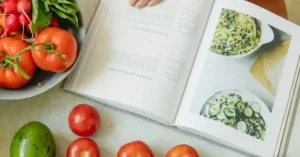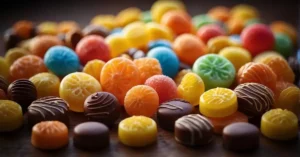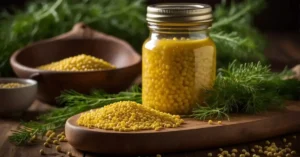Bavaria’s kitchens cook up a storm with their age-old recipes. But hey, not every bite suits every tongue. Fancy a splash of something unique? Dive into the world of Bavarian Mustard. This zesty sidekick jazzes up oodles of dishes, sprinkling a pinch of magic across Bavarian, and by extension, German grub. Ever wondered what secrets Bavarian Mustard holds? We’re peeling back the layers. You’re about to discover why this condiment is your kitchen’s unsung hero. Get ready for a flavour explosion.
History of Bavarian Mustard
You might find yourself intrigued by the rich tapestry that is the history of Bavarian mustard. This condiment, deeply rooted in the traditions of Bavaria, particularly Munich, has been a staple in German cuisine for centuries.
Bavarian mustard is traditionally known for its unique flavor profile, which differs significantly from other German mustard varieties like Düsseldorf’s Löwensenf. This mustard is not only a culinary delight but also a part of Bavaria’s cultural heritage. The inception of what you now recognize as Bavarian mustard can be traced back to Johann Conrad Develey in the 19th century.

In the heart of Munich, Develey’s concoction of vinegar, spices, and sugar combined with yellow and brown Senf came to life. The process involved boiling the mixture with hot pokers, which enhanced the flavors and created a distinct taste that has been cherished ever since. This creation has stood the test of time, remaining a favorite to this day.
The evolution of Bavarian mustard has seen it become a culinary icon, with its use transcending the borders of Germany. Its distinctive, sweet, yet tangy flavor has made it a beloved addition to numerous dishes. As you enjoy Bavarian mustard, you’re not just savoring a condiment; you’re experiencing a piece of Bavarian history.
Basic Ingredients

Bavarian sweet mustard, a staple in German cuisine, is a delightful condiment that you can easily recognize by its creamy texture and distinctive tang. Crafting this mustard involves a mix of simple yet flavorful ingredients, each playing a crucial role in shaping its unique taste.
| Ingredient | Purpose | Common Varieties |
|---|---|---|
| Mustard Seeds | Base of the mustard | Yellow (milder) and Brown (spicier) |
| Vinegar | Preserves and adds acidity | Wine vinegar or apple cider vinegar |
| Salt | Enhances and balances flavors | |
| Sugar | Adds sweetness to the mustard | White sugar, brown sugar, honey |
| Water | Adjust consistency | |
| Spices & Herbs | Create distinct taste profiles | Cloves, nutmeg, allspice, juniper berries |
Mustard seeds are the heart of Bavarian mustard, and using a combination of yellow and brown seeds allows you to adjust the spice level. Vinegar, another key ingredient, not only provides a sharp, tangy kick but also preserves the mustard. The addition of salt is crucial for flavor enhancement, while sugar is used to counterbalance the acidity and contribute to the signature sweetness of Bavarian sweet mustard.
Various additional spices and herbs are included to introduce complex notes to the condiment. Common choices include cloves and nutmeg, which can offer warmth and depth. Water is included to aid in achieving the perfect consistency for spreading or dipping. Some recipes might call for a bit of oil to enrich the texture.
Remember, the precise blend and proportion of these ingredients can vary, but they all unite to create the rich and satisfying taste that pairs wonderfully with a myriad of traditional German dishes.
Traditional Bavarian Sweet Mustard
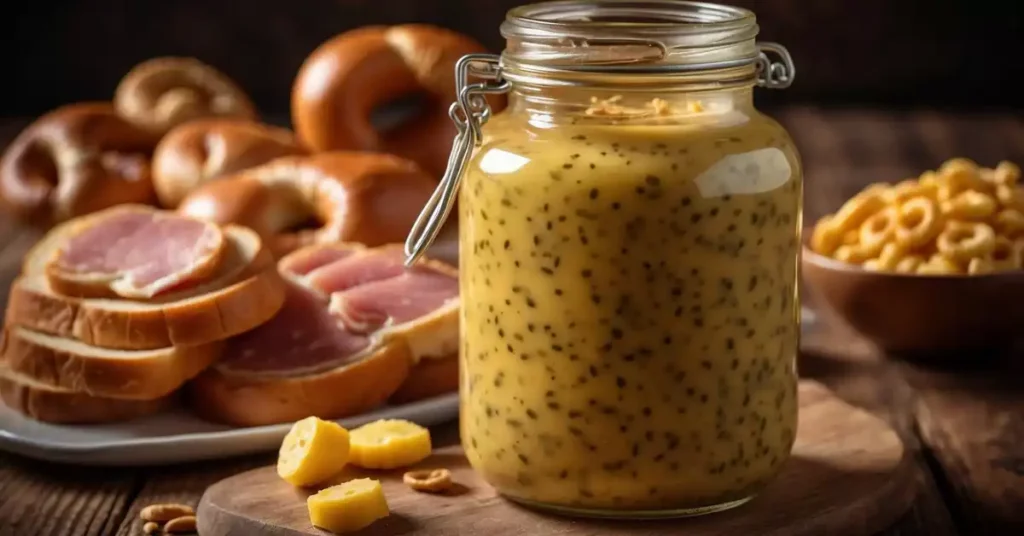
Dive into the world of Bavarian Sweet Mustard, a staple in Munich’s gastronomy, known for its harmonious blend of sweetness and spices that give it a unique depth of flavor.
Recipe Variations
Bavarian sweet mustard, locally known as ‘Süßer Senf’, is traditionally homemade and offers a variety of recipes tailored to individual taste preferences. The core ingredients typically include mustard powder, brown sugar or honey for sweetness, and a distinctive blend of spices such as cloves and allspice berries. Some variations might even add a hint of cinnamon or nutmeg for an extra layer of flavor. Vinegar is a common addition that balances the sweetness and adds a tangy note.
Basic Homemade Bavarian Sweet Mustard Recipe:
| Ingredient | Measurement |
|---|---|
| Mustard Powder | 1 cup |
| Brown Sugar/Honey | 1/2 cup |
| White Vinegar | 1/2 cup |
| Water | 1/2 cup |
| Cloves (ground) | 1/2 tsp |
| Allspice Berries | 1/4 tsp |
| Cinnamon (optional) | 1 stick |
To craft your own Bavarian sweet mustard, simply whisk these ingredients together before bringing the mixture to a gentle simmer, allowing the flavors to meld beautifully.
Serving Suggestions

Your homemade sweet Bavarian mustard isn’t just for the famous Weißwurst; it complements a wide range of Bavarian dishes. Whether you’re enjoying a hearty slice of Leberkäs or savoring a classic pretzel at a local Biergarten, this mustard is an essential accompaniment. It also pairs excellently with sausages, adding a delightful twist to the flavors. Don’t forget to try it with schnitzel too, as its sweetness provides a perfect contrast to the dish’s crispy, savory notes.
Making Bavarian Mustard at Home
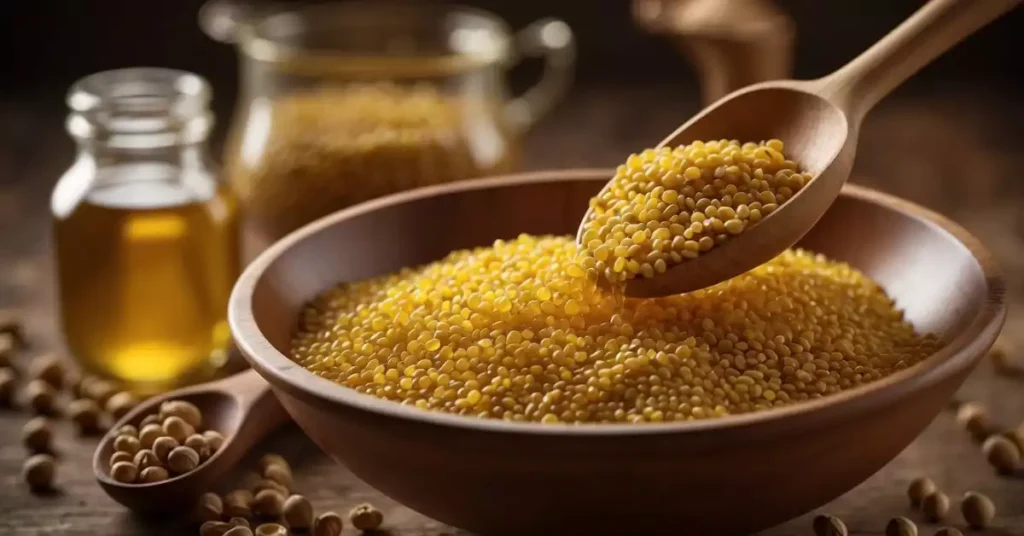
Creating homemade Bavarian mustard allows you to savor a condiment that bridges generations with its sweet, tangy flavor and smooth texture. Perfect as a spread or dip, it elevates simple dishes to gourmet delicacies with mere spoonfuls.
Equipment Needed
To craft this traditional spread right in your kitchen, you need:
- A food processor, coffee grinder, or blender: These are essential for grinding mustard seeds into powder.
- Measuring cups and spoons: For accurate ingredient portions.
- A medium saucepan: Required for combining and cooking ingredients.
- A glass jar or bottle: For storing your homemade mustard.
Storage and Preservation

To ensure your Bavarian mustard remains as fresh as the day you made it:
- Refrigerate: Always keep your mustard refrigerated.
- Containers: Use airtight glass jars or bottles to maintain freshness.
- Shelf Life: Your mustard will typically stay fresh for up to a month when stored properly.
- Label: Date your mustard after making it to keep track of its freshness.
Remember, Bavarian mustard is not just a recipe; it’s a tradition encapsulated in a jar, enlivening your meals with a taste of history.
Health and Nutrition
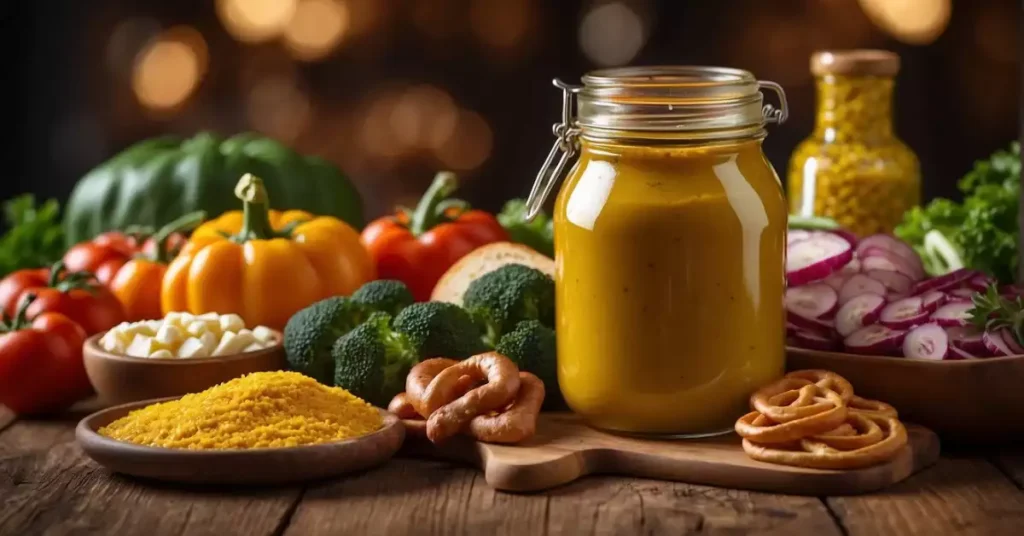
Have you ever pondered the health impacts of the condiments you add to your meals? Bavarian mustard, for instance, isn’t just a flavorful addition to your dishes; it can contribute to your nutritional intake in subtle ways.
Nutritional Profile of Bavarian Mustard:
| Nutrient | Amount (per tablespoon approx.) |
|---|---|
| Calories | 20 |
| Fat | 0g |
| Protein | 0g |
| Fiber | 0g |
| Sodium | 220mg |
Though Bavarian mustard is low in calories, fat, fiber, and protein, it still offers some health benefits due to its various components. In particular, mustard seeds contain antioxidants that can play a role in disease prevention. When you include Bavarian mustard in your diet, you’re treating yourself to a condiment that’s not high in fats unlike many other options.
Health benefits associated with mustard include its potential to aid with digestive health because of the spices it contains. These spices can stimulate the digestion process. Keep in mind, though, that while Bavarian mustard can be part of a healthy diet, it’s essential to use it in moderation, especially if you’re monitoring your sodium intake, as it can be relatively high in salt.
When you’re reaching for a condiment to spice up your meal, Bavarian mustard can be a tangy, low-calorie option to consider. Just remember, while it may not significantly contribute to your daily fiber or protein goals, it is a guilt-free way to enhance flavor without packing on extra calories or unhealthy fats.
Culinary Uses Beyond the Basics

Bavarian mustard isn’t just a typical condiment; it offers a versatile range of uses in cooking. Ideal for when you’re looking to add a bit of zest to your dishes, this mustard’s distinct flavor enhances everything from simple snacks to complex sauces.
Experiment in Sandwiches: Give your sandwiches an upgrade by using Bavarian mustard as a flavorful spread. Its rich taste pairs well with both meats and cheeses, elevating the ordinary to exceptional.
Salad Dressings: Transform your salads by whisking Bavarian mustard into your dressings for a touch of sweetness and tang. It binds other ingredients beautifully, creating emulsions that cling to greens and veggies.
Marinades: Exploring with marinades? Here’s a suggestion – add Bavarian mustard to your mixture. It not only imparts flavor but also helps to tenderize meats.
As a Dip: Your guests will love it when you serve Bavarian mustard as a dip. Its robust flavor complements everything from pretzels to crudités.
Enhancing Spreads: Incorporate Bavarian mustard into spreads for wraps, bagels, and crackers to introduce a new dimension of taste.
Potato Salad Perfection: Stir Bavarian mustard into your potato salad for an unexpected twist that provides both moisture and a burst of flavor.

| Occasion | How to Use Bavarian Mustard |
|---|---|
| BBQs | Marinade for grilled meats |
| Lunch Time | Spread on artisan sandwiches |
| Salad Refresh | Whisked into vinaigrettes |
| Snack Upgrade | Dip for assorted finger foods |
| Picnic Baskets | Enriching ingredient in potato salad |
Embrace these culinary explorations, and watch as your dishes take on a delightful and distinct Bavarian twist!
Varieties and Comparisons

Discover the world of Bavarian mustard, a flavorful condiment appreciated for its unique taste and rich variety. Let’s dive into the distinctive regional types, the spectrum of flavors from sweet to spicy, and the textures that range from smooth to grainy.
Regional Varieties
Bavarian mustard, or “Süßer Senf,” is traditionally associated with Bavaria and possesses its own sweet and mellow flavor, distinct from other German mustards. While Bavarian Sweet mustard is famed for its use with Weisswurst, other regions in Germany, like Düsseldorf, are known for their spicier mustards, such as Löwensenf, which has a hot and robust flavor.
Spice Levels and Flavors

The spice levels and flavors of Bavarian mustard can be quite different from what you might find in American yellow mustard, which tends to be milder. Bavarian varieties range from sweet to hot and achieve their unique flavor profiles by varying the blend and grind of mustard seeds and the choice of sweetener, such as honey, sugar, or applesauce.
| Mustard Type | Spice Level | Sweetness | Flavor Note |
|---|---|---|---|
| Bavarian Sweet Mustard | Low | High | Sweet, Mellow |
| American Yellow Mustard | Low | Low | Tangy, Mild |
| Löwensenf | High | Moderate | Spicy, Strong |
Condiment Textures
Mustard textures can enhance how you experience their flavor. Bavarian sweet mustard is known for a smooth consistency, with a base of finely ground mustard seeds, whereas mustards like whole grain varieties offer a grainy texture and a more intense depth of flavor. The presence of whole mustard seeds can alter both the mouthfeel and the intensity of the mustard’s kick.
Complementary Foods and Pairings

Discovering the perfect match for Bavarian mustard can transform your meals into a delightful experience. This tangy and slightly sweet condiment is a staple in Bavarian cuisine, often finding its place alongside a variety of traditional dishes.
Traditional Pairings
| Food | Description |
|---|---|
| Weißwurst | A white Bavarian veal sausage, traditionally served with Bavarian sweet mustard. |
| Leberkäs | A meatloaf-like specialty that pairs wonderfully with the mustard’s slight sweetness. |
| Pretzels | Soft, warm, and salted pretzels dipped in mustard are a classic Bavarian treat. |
Versatile Combinations
- Schnitzel: Whether it’s pork or chicken, a dollop of Bavarian mustard can add a zesty twist.
- Pickles: Combine with mustard for a sharp and vibrant flavor contrast in your Brotzeit platter.
Sandwich Accents

Use Bavarian mustard to elevate your sandwiches—the balance of tang and sweetness complements both cold cuts and cheeses.
Remember, the versatility of Bavarian mustard allows you to experiment and find the pairings that suit your palate, whether it’s a traditional serving with weißwurst or an inventive new combination.
Do-It-Yourself Mustard Making Tips

Crafting your own Bavarian mustard at home can be a rewarding venture, offering a burst of flavor that store-bought versions can’t match. Here’s a simple guide to help you create that perfect balance of sweet and piquant right in your kitchen.
Ingredients:
| Ingredient | Quantity | Purpose |
|---|---|---|
| Mustard seeds | 1 cup | Base of the mustard |
| Vinegar/cider | 1/2 cup | Acidity component |
| Water | 1/2 cup | To adjust thickness |
| Salt | 1 tsp | Flavor enhancer |
| Sugar/honey | 1-3 tbsp | Sweetness |
| Spices (optional) | As per taste | Custom flavoring |
Preparation Steps:
- Select Your Seeds: Begin with good quality mustard seeds—yellow for a mild flavor or brown/black for extra heat.
- Soak Your Seeds: Soak the mustard seeds in a mixture of vinegar and water. You could also use cider for a fruity note.
- Blend for Consistency: After soaking, blend the seeds to your desired consistency; smooth for a more refined texture or coarse for a rustic feel.
- Spice It Up: Personalize your mustard with spices—add a pinch of turmeric for color, ginger for zing, or even a clove of garlic for depth.
- Sweeten the Mix: Introduce sugar or honey into your blend for that characteristic Bavarian sweetness.
- Let It Mellow: Once mixed, let your mustard rest for a few days. The flavors will meld, and the harshness will soften.
Remember, patience is key. Your homemade mustard’s flavor will develop and mature over time, so give it a chance to achieve its full potential. Experiment with different spices to find your signature style, whether it’s a classic sweet Bavarian or something with a spicy twist. Enjoy the process, and prepare to impress with your custom condiment!
Our Opinion about Bavarian Mustard
As you can see, there are many ways to incorporate Bavarian mustard into your dish. We have learned how the mustard is made and what varieties are available. We also learned which dishes are best served with mustard. We hope that you have found a way to use mustard in your dishes. We’d love to hear about it in the comments below the article.
FAQ about Bavarian Mustard
Is Bavarian Mustard spicy?
Yes, Bavarian Mustard has a mild to moderate level of spiciness, making it suitable for most palates.
What are the ingredients in Bavarian Mustard?
The main ingredients typically include mustard seeds, vinegar, water, salt, and various spices for flavor.
How should Bavarian Mustard be stored?
Bavarian Mustard should be stored in a cool, dry place and refrigerated after opening to maintain its freshness and flavor.
Have you tried to spice up your dishes with Bavarian Mustard? Let us know in the comments below.


